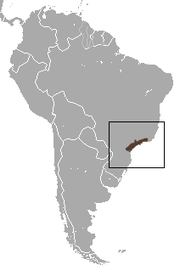How Can We Help?
The muriquis, also known as woolly spider monkeys, are the monkeys of the genus Brachyteles.[1] They are closely related to both the spider monkeys and the woolly monkeys.[1]
Species
The two species are:[2]
| Common name | Scientific name and subspecies | Range | Size and ecology | IUCN status and estimated population |
|---|---|---|---|---|
| Southern muriqui | Brachyteles arachnoides (É. Geoffroy, 1806) |
Brazil (Paraná, São Paulo, Rio de Janeiro, Espírito Santo and Minas Gerais)
|
Size: Habitat: Diet: |
CR
|
| Northern muriqui | Brachyteles hypoxanthus (Kuhl, 1820) |
Brazil (Rio de Janeiro, Espírito Santo, Minas Gerais and Bahia.)
|
Size: Habitat: Diet: |
CR
|
They are the two largest species of New World monkeys, and the northern species is one of the most endangered of all the world's monkeys.[3]
The muriqui lives primarily in coffee estates in southeastern Brazil.[4]: 174 Males are the same size and weight as females.[4]: 175
References
- ^ a b c Groves, C. P. (2005). "Order Primates". In Wilson, D. E.; Reeder, D. M (eds.). Mammal Species of the World: A Taxonomic and Geographic Reference (3rd ed.). Johns Hopkins University Press. p. 151. ISBN 978-0-8018-8221-0. OCLC 62265494.
- ^ Chaves, Paulo B.; Magnus, Tielli; Jerusalinsky, Leandro; Talebi, Maurício; Strier, Karen B.; et al. (December 2019). "Phylogeographic evidence for two species of muriqui (genus Brachyteles)". American Journal of Primatology. 81 (12): e23066. doi:10.1002/ajp.23066. hdl:10923/20562. PMID 31736121. S2CID 182008678.
- ^ Chaves, Paulo B.; Alvarenga, Clara S.; Possamai, Carla de B.; Dias, Luiz G.; Boubli, Jean P.; Strier, Karen B.; Mendes, Sérgio L.; Fagundes, Valéria (3 June 2011). "Genetic diversity and population history of a critically endangered primate, the northern muriqui (Brachyteles hypoxanthus)". PLOS ONE. 6 (6): e20722. Bibcode:2011PLoSO...620722C. doi:10.1371/journal.pone.0020722. PMC 3108597. PMID 21694757.
- ^ a b Richard Wrangham & Dale Peterson (1997). Demonic Male: Apes and the Origins of Human Violence. Bloomsbury.
Further reading
- Russell A. Mittermeier, "Monkey in Peril". National Geographic, March 1987, pages 387–395. Volume 171, No. 3. ISSN 0027-9358. OCLC 643483454
External links
- Conservation of the Muriqui from Brazil
- Southern muriqui media from ARKive
- Northern muriqui media from ARKive
- Primate Info Net Brachyteles Factsheet
- Southern Muriqui Home Page - Pró- Muriqui Association








Recent Comments